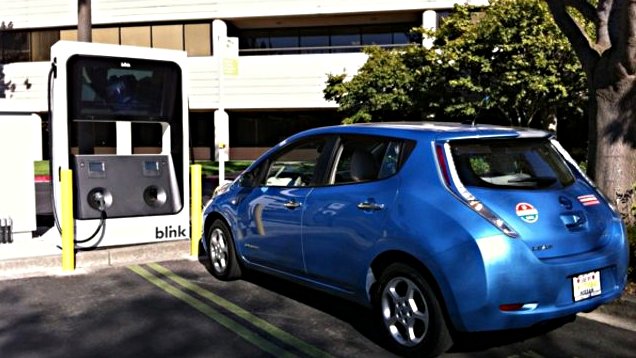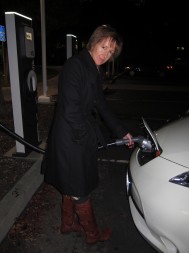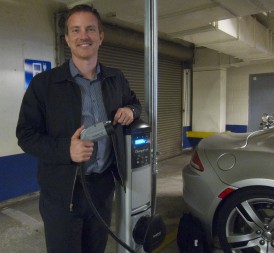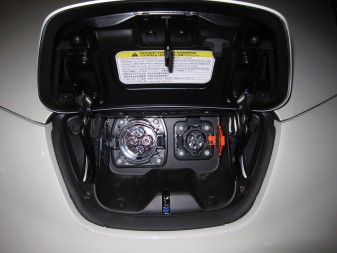Growing Pains for California's Electric Car Charging Network
Growing Pains for California's Electric Car Charging Network

Imagine pulling up to a gas station and finding out that the pumps aren’t working or that you have to be a subscriber to fill up. Those are just a couple of the challenges that drivers of electric cars face as public charging stations slowly roll out. Alison van Diggelen, herself an early adopter, explores the growing pains of building an electric car charging network and the fledgling new industry rising up to meet the challenge.
________
Range Anxiety - A Short Leash

Electric vehicles are a popular and growing trend in California. But it can take hours to charge them, and there are only a handful of fast chargers in the whole state. I recently visited one of California’s fast chargers at a Silicon Valley software company’s parking lot in Menlo Park, eager to get a charge for my all-electric Nissan Leaf. I’d traveled over 35 miles (that’s 70 round trip) from my home charger, and range anxiety had kicked in.
Eventually, I did make it home, but only after bypassing another fast charger that required I swipe a membership card which I don’t have. I used an app on my phone to find the charger.
John O'Dell, Senior Editor at Edmunds.com says for electric cars to catch on it's vital to have a reliable charging network.
“Public charging infrastructure is critical to the widespread acceptance of plug-in and particularly battery electric vehicles. Because without public chargers you basically have a fairly short leash on your vehicle and you are not going to be willing to drive it long distances.”
Although most driving and charging takes place within 40 miles of home, the lack of freedom to go much further has become a roadblock to purchasing electric cars for many Americans.
Loosening the Leash
Terry O’Day, with New Jersey-based energy company NRG, is hoping to loosen the leash on electric cars. I caught up with him at a charger at a San Francisco parking garage. As part of a settlement over claims stemming from California’s energy crisis, NRG will install 200 fast-chargers and wiring for 10,000 standard chargers statewide by 2016. NRG is calling its fast chargers, “Freedom stations.”
“You’re not tethered to a radius…this is much more like a gasoline fueling infrastructure where you can fast fill anywhere you need to go,” says O’Day.

Fast chargers can give fifty miles of driving range in fifteen minutes. But because there are only a few, drivers usually opt for a standard charger, which can take more than three hours to get the same driving range.
Fast Charger Challenges
“We are looking for a well distributed network, like a cell phone network. It’s a small “d” democratic network that provides freedom to move within a region,” says O’Day.
Still, a multitude of challenges face NRG and other charging companies, like Bay Area-based ChargePoint and Ecotality. Fast chargers produce very high voltage. They require complicated permitting. And they cost upward of $40,000 each.
Right now, the financials don’t add up says NRG’s Terry O’Day.
“The public charging infrastructure is extraordinarily expensive and there aren’t enough cars right now so there isn’t an effective business model to make the investment work,” he says.
So how many companies does it take to install a comprehensive network of electric vehicle chargers?
“It’s not as simple as changing a light bulb,” says Ravi Brar, CEO of Ecotality, in San Francisco. “It takes some effort, cooperation and coordination. It’s a sea change… a revolution in transportation. The biggest challenge might be that there are a hundred little challenges.”
But to date, there hasn’t been much coordination. There are two different standards for fast chargers: one US-European, one Japanese. It’s much like the format war between VHS and Betamax. One of them will likely lose.

And to complicate matters, Tesla Motors, a leading electric car company, is building a proprietary network of fast chargers, which won’t work with either standard.
Pat Romano, CEO of ChargePoint in Silicon Valley, describes the current state of electric car charging as “somewhat of a mess,” but he’s optimistic the fast charger standards will get sorted out in time.
The Second Inning
Romano takes a long view and uses a baseball analogy, describing 2009 as the “first inning,” when modern chargers were first going in and electric cars were just being announced by car makers. Today, he says we are solidly in the second inning.
To date, about 50,000 plug-in cars have been sold in the U.S. About one third of those sales were made in California, thanks to pioneering state rules that include rebates and carpool privileges for drivers of electric cars.
There are over 1000 public chargers in California today. Romano predicts a tipping point by the end of 2014, when he expects to see hundreds of thousands of electric cars on the road and lots more chargers.
“When we hit about the 5th or 6th inning the mass market is really taking it up,” says Romano.
For early adopters like Terry O’Day, of NRG, it’s not surprising the demand is growing for electric vehicles.
“It’s quick off the line, unexpectedly fast, it’s quiet. You feel like you’re part of a revolution when you’re in the seat of an EV,” he says.
Like many enthusiasts, he believes more chargers will help boost electric car sales. Under the NRG mandate, fast chargers alone are set to quadruple in California in the next year. And just as all eyes were on California as the state launched its Cap-and-Trade program, the world will be watching to see if this public charger roll out helps jump start electric car sales in 2013.
____
More resources on Electric Driving and Charging
Clean Car Diaries - over 25 stories from the Quest team on driving electric cars
Alternative Fuels Data Center - Dept. of Energy Resource for EV Charging, locations and incentives
Driving Electric - Online community for plug-in drivers
San Francisco BayLEAFs - Facebook community for Nissan Leaf drivers
Map of Charger Locations - Locations and reviews of all charger types, public and private, nationwide
